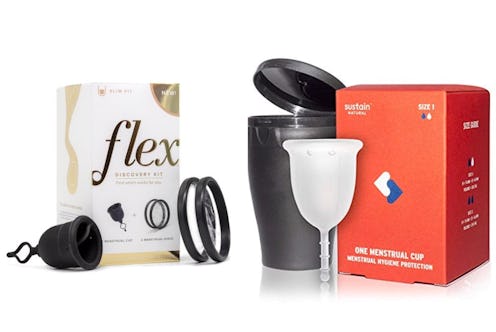Life
OB/GYNs Reveal How To Choose The Best Menstrual Cup For You

Menstrual cups are a popular, eco-friendly alternative to tampons and pads. While just a few years ago there were only a handful of menstrual cups on the market, there are now well over a dozen different kinds of these reusable period products. With so many brands to choose from — each specializing in something unique — buying the right menstrual cup can be a challenge. However, OB/GYNs say choosing the right menstrual cup for you boils down to a few important factors.
Though they aren’t for everyone, menstrual cups boast a ton of benefits. As the Cleveland Clinic reported, menstrual cups create less environmental waste, lower the costs of your period over your lifetime, and typically only need to be emptied and cleaned every 10 to 12 hours (compared to tampons, which need to be switched out every four to eight hours). Ultimately, Alyssa Dweck, MD, an OB/GYN in Westchester, NY, tells Bustle that menstrual cups “may take some trial and error to get accustomed to use,” but they should feel comfortable. In fact, Dweck says most people don’t feel the cups at all if they’re in place properly.
Whether you’re looking for a menstrual cup that’s compact and discreet, made for people with heavy flows, or designed for beginners, there’s one out there for you. Here are seven things to consider when picking a menstrual cup, according to OB/GYNs.
1The Shape And Size Of Your Pelvis
Dr. Jessica Shepherd, an OB/GYN and gynecologic surgeon at Baylor University Medical Center, says that to find the right menstrual cup, you first have to get familiar with your anatomy. She explains that, "Knowing your pelvis is the best place to start — meaning, how your pelvis is shaped, and knowing what would be more comfortable than not." According to the Mayo Clinic, menstrual cups may not fit comfortably or correctly if your uterus is lo, or abnormally shaped (like being tilted, for example). If that's the case, you may have to shop around for a menstrual cup specifically designed for a low cervix — and, it may take a couple cups before you find one that feels snug. Further, Shepherd says you may also have to research how (and if) a menstrual cup folds so you can find the right fit for your body.
2The Materials Used In Production
According to Dr. Shepherd, it's always important make sure "you don't have an allergy to the materials used in the composition of the cup." If you have a latex or rubber allergy — or just have skin sensitivities in general — you'll probably want to buy a menstrual cup that is latex-free, and hypoallergenic. On top of the Diva Cup, another option is the Cora Cup, which is also made from 100% medical grade silicone, and for each purchase of a Cora cup, the company provides a three-month supply of pads, and health education to a girl in need through global organizations they've partnered with.
3How You Remove The Cup
You may want to check out the stems on the menstrual cups when perusing your buying options. Dweck says that, "Many have a stem with ribs or grips, so it's easily removable." What's more, some come with longer stems so you can trim it to the correct length to make your cup feel more snug. But if using these pull tabs is challenging for you, a new menstrual cup, called the Flex Cup, that features a patented loop to make pulling the cup out — and breaking the cup's suction — super easy.
4The Reliability Of The Brand
Shepherd explains that you should never buy a cup based on what's "trendy," or the brand name and packaging alone. "It really should be something that is specific to the needs of your menstrual cycle, and your anatomy," she says.
5The Menstrual Cup's Size
"Some cups may not be adequate for heavy bleeders," Shepherd says, so it's important to research how much blood a menstrual cup can hold before buying one. Depending on your budget, there are several menstrual cups on the market for people with heavy flows available. Dweck says to look for menstrual cups that are "narrow for light flow, [and] wider for heavy flow." Even if you buy a cup with a larger capacity, however, you may have to empty it more frequently on days your period is extra heavy to prevent leakage.
6How You Sanitize The Cup
Dweck explains most menstrual cups are washable with soap and water, and that you can also wipe them down when you're in a hurry. However, some cups may require you boil them after each cycle to disinfect them. Understanding how to properly clean the menstrual cup you buy can ensure it stays free of bacteria and germs, and it can help extend the life of your cup in the long run.
7The Firmness
Feel and rigidity can differ from menstrual cup to menstrual cup. Shepherd says to "assess for firmness" before buying one of these period products. Why? According to the menstrual cup review site Put A Cup In it, "In general, softer cups are more comfortable because they don’t apply any outward pressure, but, they can be harder to get open inside." Oppositely, Put A Cup In It explains firm cups are typically better for beginners, as they open up easier once inside. If you have intense period cramps, or bladder sensitivities, a soft cup like the new Saalt Soft Cup tends to be more comfortable and gentle.
"Cups come with a learning curve, so it is important to try a few times before giving up on one," Shepherd says. Not all menstrual cups are created equal; however, putting in some time to research your cup options can save you money, and time down the road. Choosing a menstrual cup really comes down to your personal preferences and priorities, so you can have the most comfortable, leak-free, and eco-friendly period possible.